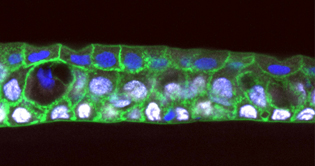Selected Publications Skin & Wound healing

-
Hatzold J, Nett V, Brantsch S, Zhang JL, Armistead J, Wessendorf H, Stephens R, Humbert PO, Iden S and Hammerschmidt, M. (2023). Matriptase-dependent epidermal pre-neoplasm in zebrafish embryos caused by a combination of hypotonic stress and epithelial polarity defects. PLOS Genetics 19(8): e1010873.
-
Hatzold, J., Wessendorf, H., Pogoda, H.M., Bloch, W. and Hammerschmidt, M. (2021). The Kunitz-type serine protease inhibitor Spint2 is required for cellular cohesion, coordinated cell migration and cell survival during zebrafish hatching gland development. Dev. Biol. Vol. 476, 148-170.
- Armistead J., Hatzold J. , van Roye A., Fahle E., Hammerschmidt M. (2020). Entosis and apical cell extrusion constitute a tumor-suppressive mechanism downstream of Matriptase. J. Cell Biol. 2020 Vol. 219 No. 2
- Hatzold, J., Beleggia, F., Herzig, H., Altmüller, J., Nürnberg, P., Bloch, W., Wollnik, B., Hammerschmidt, M. (2016). Tumor suppression in basal keratinocytes via dual non-cell-autonomous functions of a Na,K-ATPase beta subunit. eLife 5: e14277.
- Richardson, R., Metzger, M., Knyphausen, P., Ramezani, T., Kraus, C. Schmelzer, E., Hammerschmidt, M. (2016). Re-epithelialisation of cutaneous wounds in adult zebrafish combines mechanisms of wound closure in embryonic and adult mammals. Development 143: 2077-2088
- Knipper, J.A., Willenborg, S., Brinckmann, J., Bloch, W., Maaß, T., Wagener, R., Krieg, T., Sutherland, T., Munitz, A., Rothenberg, M.E., Niehoff, A., Richardson, R., Hammerschmidt, M., Allen, J.E., Eming, S.A. (2015). Interleukin-4 receptor alpha signaling in myeloid cells controls collagen fibril assembly in skin repair. Immunity 43: 803-816.
- Westcot, S.E., Hatzold, J., Urban, M.D., Richetti, S.K., Skuster, K.J., Harm, R.M., Lopez Cervera, R., Umemoto N., McNulty, M.S., Clark, K.J., Hammerschmidt, M., Ekker, S,C. (2015). Protein-Trap insertional mutagenesis uncovers new genes involved in zebrafish skin development, including a neuregulin 2a-based ErbB signaling pathway required during median fin fold morphogenesis. PLoS One 10: e0130688
- Richardson, R., Gebauer, J.M., Zhang, J.L., Kobbe, B., Keene, D.R., Karlson, K.R., Richetti, S., Wohl, A.P., Sengle, G., Neiss, W.F., Paulsson, M., Hammerschmidt, M.* and Wagener, R.* (2014). AMACO is a novel component of the basement membrane associated Fraser complex. J. Invest. Dermatol. 134: 1313-1322 (*joint corresponding authors)
- Fischer, B., Metzger, M., Richardson, R., Knyphausen, P., Ramezani, T., Franzen, R., Schmelzer, E., Bloch, W., Carney, T.J. and Hammerschmidt, M. (2014). p53 and TAp63 promote keratinocyte proliferation and differentiation in breeding tubercles of the zebrafish. PLoS Genet. 10: e1004048.
- Richardson, R., Slanchev, K., Kraus, C., Knyphausen, P., Eming, S. and Hammerschmidt, M. (2013). Adult zebrafish as a model for cutaneous wound-healing research. J. Invest. Dermatol. 133: 1655-1665
- Feitosa, N.M., Zhang, J., Carney, T.J., Metzger, M., Korzh, V., Bloch, W. and Hammerschmidt, M. (2012). Hemicentin2 and Fibulin1 are required for epidermal-dermal junction formation and fin mesenchymal cell migration during zebrafish development. Dev. Biol. 369: 235-248
- Jänicke, M., Renisch, B. and Hammerschmidt, M. (2010). Zebrafish grainyhead-like1 is a common marker of different non-keratinocyte epidermal cell lineages, which segregate from each other in a Foxi3-dependent manner. Int. J. Dev. Biol. 54: 837-850.
- Carney, T. J., Feitosa, N., Sonntag, C., Slanchev, K., Kluger, J., Kiyozumi, D., Gebauer, J., Talbot, J., Zimmermann, C., Kimmel, C.B., Sekiguchi, K., Wagener, R., Schwarz, R., Ingham, P.I. and Hammerschmidt, M. (2010). Genetic analysis of fin development in zebrafish identifies Furin and Hemicentin1 as potential novel Fraser Syndrome disease genes. PLoS Genet. 6: e1000907
- Dodd, M.E., Hatzold, J., Mathias, J.R., Walters, K.B., Bennin, D.A., Rhodes, J., Kanki, J.P., Look, A.T., Hammerschmidt, M. and Huttenlocher A. (2009). The ENTH domain protein Clint1 is required for epidermal homeostasis in zebrafish. Development 136: 2591-2600
- Slanchev, K., Carney, T. J., Stemmler, M. P., Koschorz, M., Amsterdam, A., Schwarz, H. and Hammerschmidt, M. (2009). The epithelial cell adhesion molecule EpCAM is required for epithelial morphogenesis and integrity during zebrafish epiboly and skin development. PLoS Genet. 5: e1000563
- Jänicke, M., Carney, T. J. and Hammerschmidt, M. (2007). Foxi3 transcription factors and Notch signaling control the formation of skin ionocytes from epidermal precursors of the zebrafish embryo. Dev. Biol. 307: 258-271
- Carney, T. J., von der Hardt, S., Sonntag, C., Amsterdam, A., Topczewski, J., Hopkins, N. and Hammerschmidt, M. (2007). Inactivation of serine protease Matriptase1a by its inhibitor Hai1 is required for epithelial integrity of the zebrafish epidermis. Development 134: 3461-3471
- Bakkers, J., Camacho-Carvajal, M., Nowak, M., Kramer, C., Danger, B. and Hammerschmidt, M. (2005). Destabilization of ∆Np63a by Nedd4-mediated ubiquitination and Ubc9-mediated sumoylation, and its implications on dorsoventral patterning of the zebrafish embryo. Cell Cycle 4: 790-800
- Bakkers, J., Hild, M., Kramer, C., Furutani-Seiki, M. and Hammerschmidt, M. (2002). Zebrafish ∆Np63 is a direct target of Bmp signaling and acts as a transcriptional repressor to block neural specification in the ventral ectoderm. Dev. Cell 2: 617-627